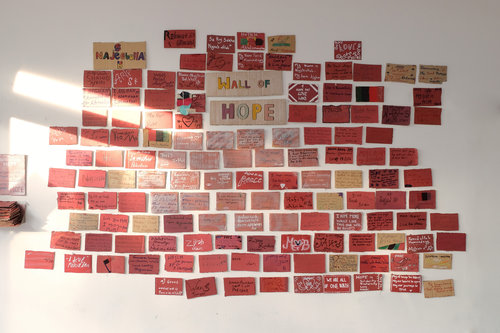- About
- Topics
- Story
- In-Depth
- Picks
- Opinion
- News
- Donate
- Signup for our newsletterOur Editors' Best Picks.Send
Read, Debate: Engage.
| November 14, 2019 | |
|---|---|
| topic: | Refugees and Asylum |
| tags: | #Cameroon, #refugees, #cash transfers, #mobile money |
| located: | Cameroon |
| by: | Bob Koigi |
But technology has come to the rescue. Not only has tech facilitated healing the refugees broken by war, it’s also ensuring transparency, streamlining distribution and creating a whole new set of markets from empowered local traders and refugees while offering dietary diversity.
One such programme is the mobile-based cash transfer system introduced by the World Food Programme in 2016 which has now reached over 48,000 refugees.
Through the model, WFP provides each refugee with a mobile phone and a SIM card which accesses an electronic portfolio allowing the refugees to receive their monthly allowances of approximately 10,000 FCFA, about US$18.
From this allowance, the refugees are free to use the money to buy food that addresses their individual family needs and in the quantity they deem fit. They can also choose to spend all of it or save some.
This concept replaces the food rations that have traditionally been predominant where the head of the family, mostly the husband, would receive a monthly ration of vital produce including sugar, oil, salt, cassava flour and beans. In the largely polygamous society, the man would then sub divide this ration among his different families.
But the mobile based cash transfer programme now recognises women as the head of homes and sends them the monthly cash payouts which gives them the freedom to decide what to buy while ensuring they depend less on their husbands. The electronic cash transfer programme has assisted the refugees in engaging in income-generating activities like setting up small shops. In fact it has sparked a local markets revolution with WFP supporting women who are running these businesses by encouraging refugees to buy from these shops.
In Gado refugee camp based in Eastern Cameroon, over 30 local traders have invested in businesses that offer diversified food products among them cassava flour which they sell to refugees.
It has also boosted women who have ventured into businesses since they have been traditionally locked out by cultural barriers.
Besides ensuring even distribution of aid, the digital transfer model has also allowed refugees safely keep their money, open electronic saving accounts while empowering them to send money directly to shopkeepers through mobile peer to peer transfer without moving around with cash. In the event that they want cash, they can withdraw it at the various mobile money agents.
Beyond Cameroon the innovative transfer programme has been successful in Kakuma refugee camp in Kenya, one of the largest globally.
This digital money transfer has been welcomed as the most convenient in reaching a large number of refugees faster and effectively. The argument is that the numerous benefits it carries among them giving the refugees freedom of choice on how to use the aid, security in handling the money, addressing the various challenges in distribution including aid not reaching its intended recipients and the ability to empower refugees to run businesses are key in maintaining the dignity of these refugees.
“There are close to 26 million refugees globally. Imagine the logistical nightmare of trying to get aid to all of them, despite that aid being limited, the cost of transporting it, then deciding what they will consume despite having different nutritional requirements due to issues like family size and then the other risks like theft of this food aid. Now imagine how all this is addressed and simplified just by going digital across the value chain. It is a concept that will not only increase the reach to more refugees but create an empowered community”, said Raphael Kioko a lecturer at the School of Security, Diplomacy and Peace Studies of Kenyatta University Kenya. He added that the extra benefits like refugees being able to pay school fees for their children, build homes and establish businesses is inspiring a refugee economy which is redefining the global refugee situation.
By copying the embed code below, you agree to adhere to our republishing guidelines.
